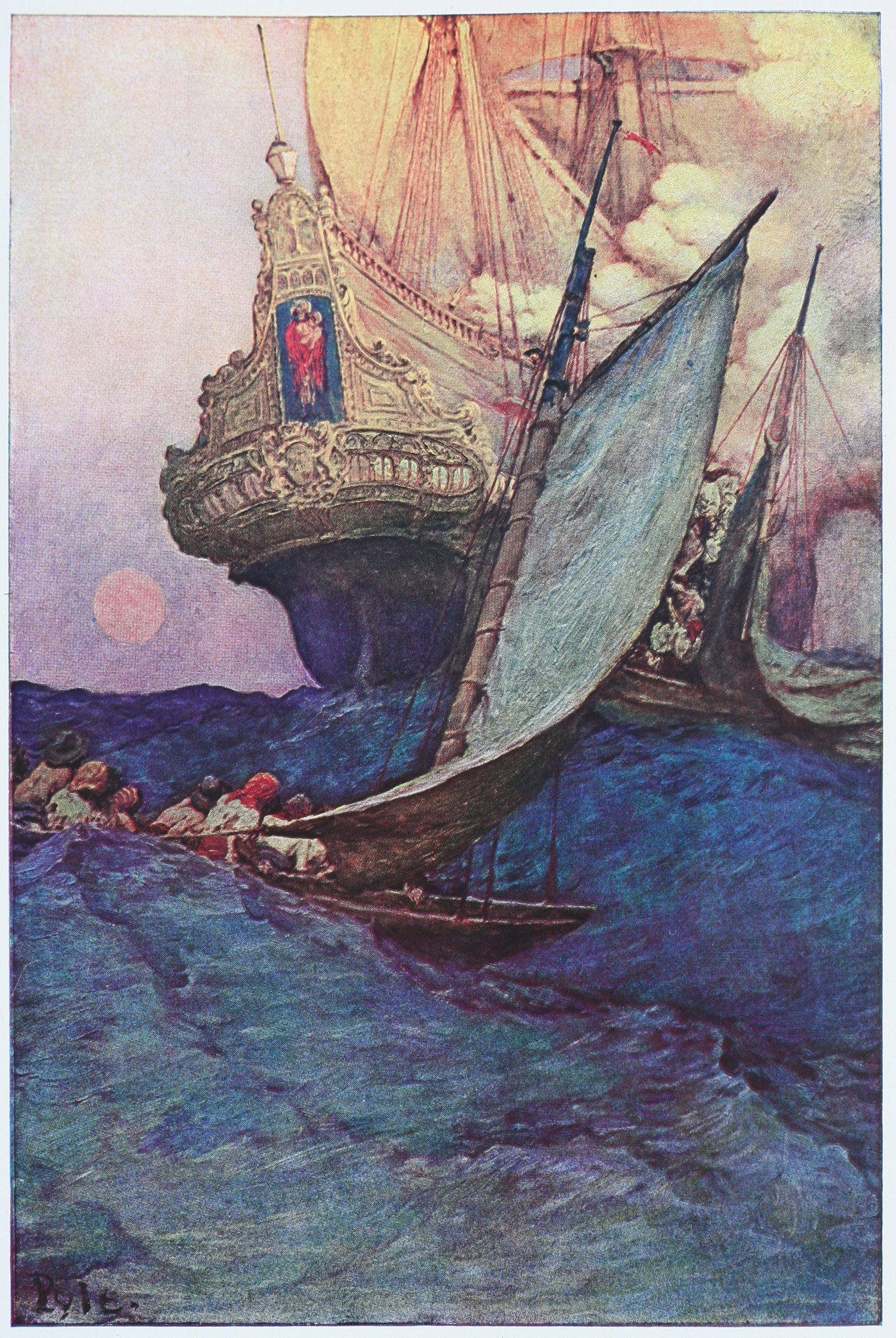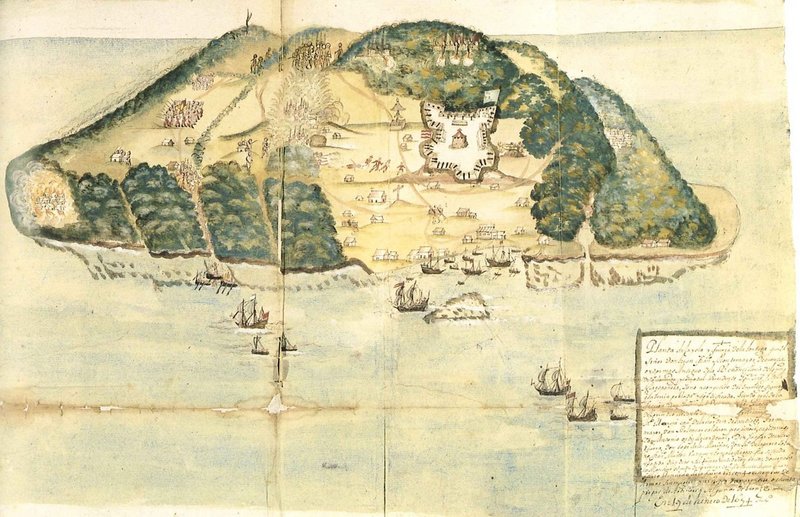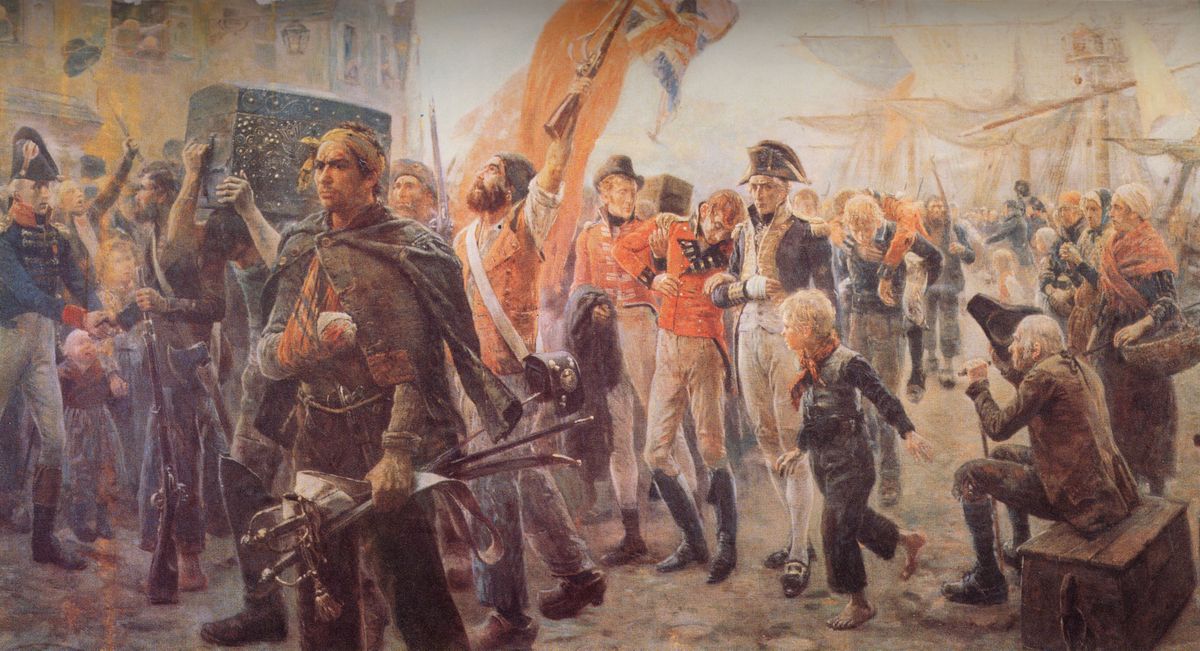|
Buccaneer
Buccaneers were a kind of privateers or free sailors particular to the Caribbean Sea during the 17th and 18th centuries. First established on northern Hispaniola as early as 1625, their heyday was from Stuart Restoration, the Restoration in 1660 until about 1688, during a time when governments were not strong enough and did not consistently attempt to suppress them. Originally the name applied to the landless hunters of wild boars and cattle in the largely uninhabited areas of Tortuga (Haiti), Tortuga and Hispaniola. The meat they caught was smoked over a slow fire in little huts the French called ''boucans'' to make ''viande boucanée'' – ''jerked meat'' or ''jerky'' – which they sold to the French corsairs, corsairs who preyed on the (largely Spanish) shipping and settlements of the Caribbean. Eventually the term was applied to the corsairs and (later) privateers themselves, also known as the Brethren of the Coast. Though corsairs, also known as ''filibusters'' or ''freeb ... [...More Info...] [...Related Items...] OR: [Wikipedia] [Google] [Baidu] |
Tortuga (Haiti)
Tortuga Island (french: Île de la Tortue, ; ht, Latòti; es, Isla Tortuga, , ''Turtle Island'') is a Caribbean island that forms part of Haiti, off the northwest coast of Hispaniola. It constitutes the ''commune'' of Île de la Tortue in the Port-de-Paix arrondissement of the Nord-Ouest department of Haiti. Tortuga is in size and had a population of 25,936 at the 2003 Census. In the 17th century, Tortuga was a major center and haven of Caribbean piracy. Its tourist industry and references in many works have made it one of the most recognized regions of Haiti. History The first Europeans to land on Tortuga were the Spanish in 1492 during the first voyage of Christopher Columbus into the New World. On December 6, 1492, three Spanish ships entered the Windward Passage that separates Cuba and Haiti. At sunrise, Columbus noticed an island whose contours emerged from the morning mist. Because the shape reminded him of a turtle's shell, he chose the name of Tortuga. Tortuga wa ... [...More Info...] [...Related Items...] OR: [Wikipedia] [Google] [Baidu] |
Privateer
A privateer is a private person or ship that engages in maritime warfare under a commission of war. Since robbery under arms was a common aspect of seaborne trade, until the early 19th century all merchant ships carried arms. A sovereign or delegated authority issued commissions, also referred to as a letter of marque, during wartime. The commission empowered the holder to carry on all forms of hostility permissible at sea by the usages of war. This included attacking foreign vessels and taking them as prizes, and taking prize crews as prisoners for exchange. Captured ships were subject to condemnation and sale under prize law, with the proceeds divided by percentage between the privateer's sponsors, shipowners, captains and crew. A percentage share usually went to the issuer of the commission (i.e. the sovereign). Privateering allowed sovereigns to raise revenue for war by mobilizing privately owned armed ships and sailors to supplement state power. For participants, privateerin ... [...More Info...] [...Related Items...] OR: [Wikipedia] [Google] [Baidu] |
Port Royal
Port Royal is a village located at the end of the Palisadoes, at the mouth of Kingston Harbour, in southeastern Jamaica. Founded in 1494 by the Spanish, it was once the largest city in the Caribbean, functioning as the centre of shipping and commerce in the Caribbean Sea by the latter half of the 17th century. It was destroyed by an earthquake on 7 June 1692, which had an accompanying tsunami, leading to the establishment of Kingston, which is now the largest city in Jamaica. Severe hurricanes have regularly damaged the area. Another severe earthquake occurred in 1907. Port Royal was once home to privateers who were encouraged to attack Spanish vessels, at a time when smaller European nations were reluctant to attack Spain directly. As a port city, it was notorious for its gaudy displays of wealth and loose morals. It was a popular homeport for the English and Dutch-sponsored privateers to spend their treasure during the 17th century. When those governments abandoned the prac ... [...More Info...] [...Related Items...] OR: [Wikipedia] [Google] [Baidu] |
Alexandre Exquemelin
Alexandre Olivier Exquemelin (also spelled ''Esquemeling'', ''Exquemeling'', or ''Oexmelin'') (c. 1645–1707) was a French, Dutch or Flemish writer best known as the author of one of the most important sourcebooks of 17th-century piracy, first published in Dutch as ''De Americaensche Zee-Roovers'', in Amsterdam, by Jan ten Hoorn, in 1678. Born about 1645, it is likely that Exquemelin was a native of Honfleur, France, who on his return from buccaneering settled in Holland, possibly because he was a Huguenot. In 1666 he was engaged by the French West India Company and went to Tortuga, where he worked as an indentured servant for three years. There he enlisted with the buccaneers, in particular with the band of Henry Morgan, whose confidante he was, probably as a barber-surgeon, and remained with them until 1674. Shortly afterwards he returned to Europe and settled in Amsterdam where he qualified professionally as a surgeon, his name appearing on the 1679 register of the Dutch Su ... [...More Info...] [...Related Items...] OR: [Wikipedia] [Google] [Baidu] |
Pierre Le Grand (pirate)
Pierre Le Grand (french: Peter the Great) was a French buccaneer supposedly active during the 17th century. He is known to history from only one source, Alexandre Exquemelin's ''Buccaneers of America'', and thus his historical existence has been questioned. Origins Pierre was born in Dieppe, France. Nothing is known of his life before his arrival in Tortuga at some time in the mid-17th century. Attack on Spanish galleon Pierre le Grand is known only for his attack on a Spanish galleon near the coast of Hispaniola in the 17th century. The exact site of the attack is uncertain; Exquemelin at one point says the Caicos Islands were the scene of the crime, and at another point places the attack at Cape Tiburón, off the southwest coast of Hispaniola. Pierre had recruited a crew of 28 men on a single small boat and sailed in search of Spanish ships to rob. After a long, fruitless cruise, his buccaneer band spotted a ship, a straggler from the Spanish treasure fleet. They voted to ... [...More Info...] [...Related Items...] OR: [Wikipedia] [Google] [Baidu] |
Hispaniola
Hispaniola (, also ; es, La Española; Latin and french: Hispaniola; ht, Ispayola; tnq, Ayiti or Quisqueya) is an island in the Caribbean that is part of the Greater Antilles. Hispaniola is the most populous island in the West Indies, and the region's second largest in area, after the island of Cuba. The island is divided into two separate nations: the Spanish-speaking Dominican Republic (48,445 km2, 18,705 sq mi) to the east and the French/ Haitian Creole-speaking Haiti (27,750 km2, 10,710 sq mi) to the west. The only other divided island in the Caribbean is Saint Martin, which is shared between France ( Saint Martin) and the Netherlands (Sint Maarten). Hispaniola is the site of one of the first European settlements in the Americas, La Navidad (1492–1493), as well as the first proper town, La Isabela (1493–1500), and the first permanent settlement, the current capital of the Dominican Republic, Santo Domingo (est. 1498). These settlements were founded succe ... [...More Info...] [...Related Items...] OR: [Wikipedia] [Google] [Baidu] |
Buccan
Buccan or Boucan is the native South American and Caribbean nameDiccionario de Etimología/ref> for a wooden framework or hurdle on which meat was slow-roasted or Smoking (cooking), smoked over a fire. Spaniards called the same process "barbacoa", later "barbecue".Oxford English Dictionary The term "buccaneer" for pirates or privateers, is said to be derived from buccan. In the Caribbean, seafarers used the wooden frames for smoking meat, preferably Pork. From this derived the French word ''boucane'' and hence the name ''boucanier'' for French hunters who used such frames to smoke meat from feral cattle and pigs on Hispaniola (now Haiti and the Dominican Republic). English colonists anglicised Anglicisation is the process by which a place or person becomes influenced by English culture or British culture, or a process of cultural and/or linguistic change in which something non-English becomes English. It can also refer to the influen ... the word ''boucanier'' to ''buccaneer ... [...More Info...] [...Related Items...] OR: [Wikipedia] [Google] [Baidu] |
French Corsairs
Corsairs (french: corsaire) were privateers, authorized to conduct raids on shipping of a nation at war with France, on behalf of the French crown. Seized vessels and cargo were sold at auction, with the corsair captain entitled to a portion of the proceeds. Although not French Navy personnel, corsairs were considered legitimate combatants in France (and allied nations), provided the commanding officer of the vessel was in possession of a valid letter of marque ( or , the latter giving ''corsairs'' their name), and the officers and crew conducted themselves according to contemporary admiralty law. By acting on behalf of the French Crown, if captured by the enemy, they could in principle claim treatment as prisoners of war, instead of being considered pirates. Because corsairs gained a swashbuckling reputation, the word "corsair" is also used generically as a more romantic or flamboyant way of referring to privateers, or even to pirates. The Barbary pirates of North Africa as wel ... [...More Info...] [...Related Items...] OR: [Wikipedia] [Google] [Baidu] |
Brethren Of The Coast
The Brethren or Brethren of the Coast were a loose coalition of pirates and privateers commonly known as buccaneers that were active in the seventeenth and eighteenth centuries in the Atlantic Ocean, Caribbean Sea, and Gulf of Mexico. They were a syndicate of captains with letters of marque and reprisal who regulated their privateering enterprises within the community of privateers and with their outside benefactors. They were primarily private individual merchant mariners of Protestant background, usually of English and French origin. During their heyday, when the Thirty Years War was devastating the Protestant communities of France, Germany, and the Netherlands while England was engaged in various conflicts, the privateers of these nationalities were issued letters of marque to raid Catholic French and Spanish shipping and territories. Based primarily on the island of Tortuga off the coast of Haiti and in the city of Port Royal on the island of Jamaica, the original ... [...More Info...] [...Related Items...] OR: [Wikipedia] [Google] [Baidu] |
Spanish Main
During the Spanish colonization of America, the Spanish Main was the collective term for the parts of the Spanish Empire that were on the mainland of the Americas and had coastlines on the Caribbean Sea or Gulf of Mexico. The term was used to distinguish those regions from the numerous islands Spain controlled in the Caribbean, which were known as the Spanish West Indies. Etymology The word "main" in the expression is a contraction of mainland.Online Etymology Dictionary: main (n.) Retrieved 20 August 2014 Composition The Spanish Main included and |
Galleon
Galleons were large, multi-decked sailing ships first used as armed cargo carriers by European states from the 16th to 18th centuries during the age of sail and were the principal vessels drafted for use as warships until the Anglo-Dutch Wars of the mid-1600s. Galleons generally carried three or more masts with a lateen fore-and-aft rig on the rear masts, were carvel built with a prominent squared off raised stern, and used square-rigged sail plans on their fore-mast and main-masts. Such ships were the mainstay of maritime commerce into the early 19th century, and were often drafted into use as auxiliary naval war vessels—indeed, were the mainstay of contending fleets through most of the 150 years of the Age of Exploration—before the Anglo-Dutch wars brought purpose-built ship-rigged warships, ships of the line, that thereafter dominated war at sea during the remainder of the age of sail. Etymology The word ''galleon'' 'large ship' comes from Old French ''galion'' 'arme ... [...More Info...] [...Related Items...] OR: [Wikipedia] [Google] [Baidu] |
Dutch Republic
The United Provinces of the Netherlands, also known as the (Seven) United Provinces, officially as the Republic of the Seven United Netherlands (Dutch: ''Republiek der Zeven Verenigde Nederlanden''), and commonly referred to in historiography as the Dutch Republic, was a federal republic that existed from 1579, during the Dutch Revolt, to 1795 (the Batavian Revolution). It was a predecessor state of the Netherlands and the first fully independent Dutch nation state. The republic was established after seven Dutch provinces in the Spanish Netherlands revolted against rule by Spain. The provinces formed a mutual alliance against Spain in 1579 (the Union of Utrecht) and declared their independence in 1581 (the Act of Abjuration). It comprised Groningen, Frisia, Overijssel, Guelders, Utrecht, Holland and Zeeland. Although the state was small and contained only around 1.5 million inhabitants, it controlled a worldwide network of seafaring trade routes. Through its tradin ... [...More Info...] [...Related Items...] OR: [Wikipedia] [Google] [Baidu] |




.jpg)


.jpg)
